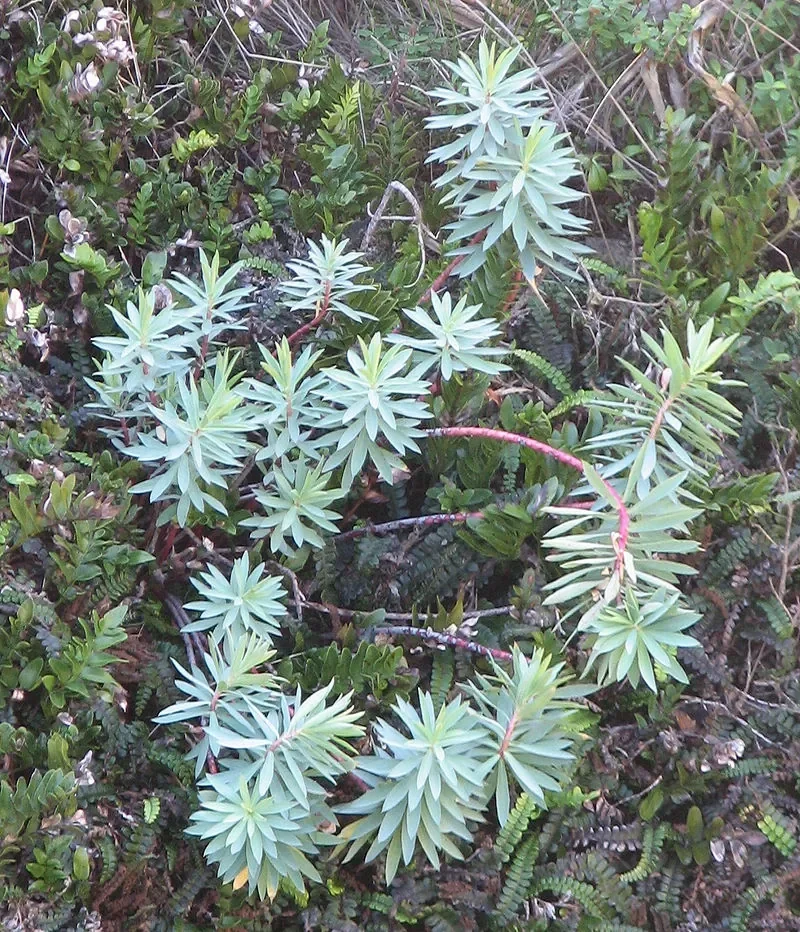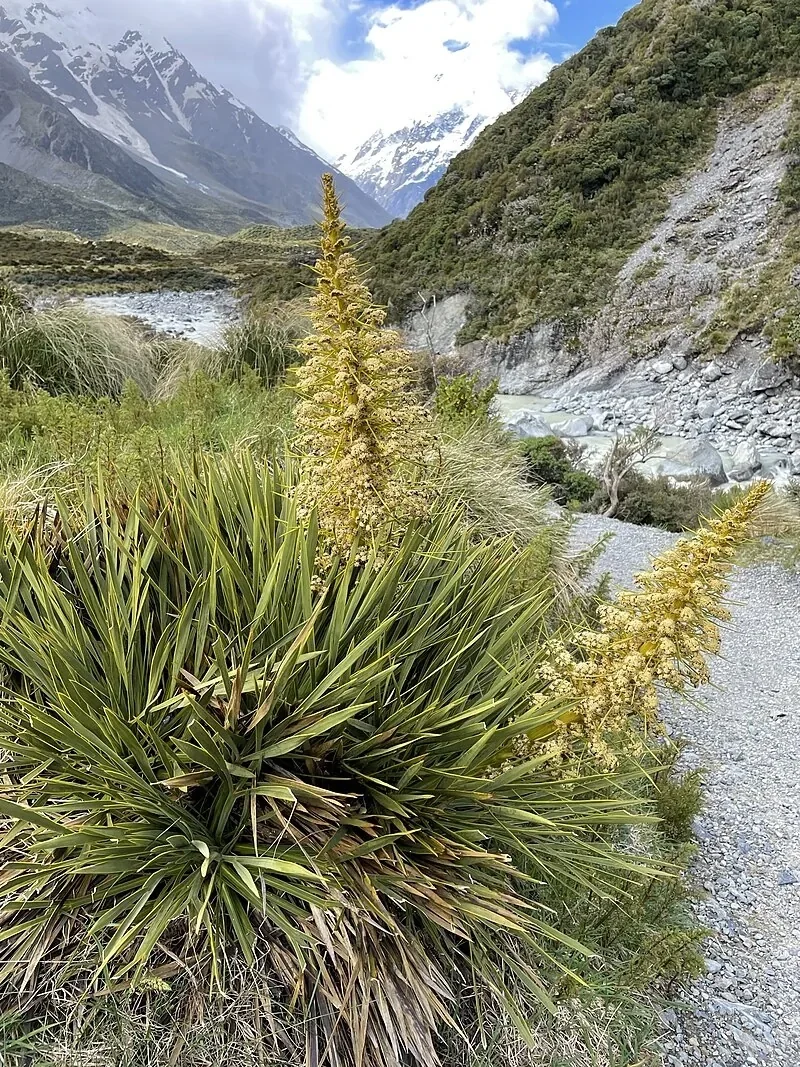
Shore Spurge
Euphorbia glauca
Introduction
Introduction Overview
Euphorbia glauca , also known as shore spurge, is a rare and striking coastal plant native to New Zealand. It is recognized for its blue-green foliage, red stems, and unique inflorescences. The plant is threatened in the wild but is valued for coastal restoration and gardens. native trees .

Plant Description
Botanical Features
Euphorbia glauca , also known as Shore Spurge or Waiā-atua, is a perennial herb endemic to New Zealand. It typically grows up to 1 meter tall, with multiple erect stems that can be reddish or green-blue, arising from creeping stems or underground rhizomes. Its foliage is distinctive, with blue-green or blue-grey leaves up to 12 cm long, arranged radially on the erect stems. A key characteristic is its milky, burning sap. Small inflorescences, or flowers, are produced near the stem tips, each surrounded by a deep red, cup-like structure, sometimes with purple glands or contrasting maroon bracts. Flowering generally occurs between October and February, followed by pendulous fruits that ripen to brown. This species is primarily a coastal plant, thriving in sand dunes, coastal banks, rocky places, gravel, and seepages near the shore. It is known for its hardiness and tolerance to coastal conditions, including wind, salt spray, and drought.
Quick Facts
Quick Facts Overview
| Scientific Name | Euphorbia Glauca |
|---|---|
| Height | 0.3-1 m |
| Spread | 0.5-1.5 m |
| Water Needs | Low; drought tolerant once established |
| Light | Full sun |
| Frost Tolerance | Low; sensitive to frost |
| Salt Tolerance | High; thrives in coastal conditions |
| Growth Rate | Moderate |
| Lifespan | Perennial |
Climate Best Suited to
Euphorbia is native to New Zealand and thrives in the country's diverse climate conditions. It adapts well to various regional climates throughout the country.
Regional Suitability
| City | Climate Suitability |
|---|---|
| Whangārei | Ideal |
| Auckland | Ideal |
| Hamilton | Ideal |
| Tauranga | Ideal |
| Rotorua | Ideal |
| Gisborne | Ideal |
| New Plymouth | Ideal |
| Napier | Ideal |
| Whanganui | Ideal |
| Palmerston North | Ideal |
| Wellington | Ideal |
| Nelson | Ideal |
| Christchurch | Ideal |
| Dunedin | Ideal |
| Invercargill | Ideal |
Natural Habitat
Euphorbia glauca , also known as New Zealand sea spurge or shore spurge, is a perennial herb endemic to New Zealand and the Chatham Islands. It is typically found in coastal environments, including sand dunes, coastal cliffs, banks, slopes, rocky lake shore scarps, and gravel and seepages near the shore.
This species is considered at risk and is in decline due to various threats such as habitat loss, browsing by domestic and feral animals (pigs, cattle, sheep, and possums), competition from taller vegetation, coastal development, road widening, and erosion.
Plant Conservation
Euphorbia glauca , also known as shore spurge, waiūatua, or sand milkweed, is a coastal plant native to New Zealand. Its conservation status is listed as "Serious Decline" by the Department of Conservation and the New Zealand Threat Classification System. It is also categorized as "Nationally Vulnerable" with qualifiers such as CI, DPS, DPT, PD, and PF.
The species faces several threats, including browsing by domestic and feral animals like stock, possums, pigs, cattle, and sheep. Habitat modification and loss due to coastal development, road widening, and erosion also contribute to its decline. Competition from taller vegetation and a fungal disease affecting some populations on the West Coast of the South Island are additional concerns.
Soil
- Well-draining soil
- Tolerates sandy soils
- pH 6.0-7.5
Light
- Full sun
- Tolerates coastal exposure
- Needs good air circulation
Water
- Low water needs
- Drought tolerant
- Sensitive to overwatering
Planting Guide
When to Plant
The best time to plant Euphorbia is during spring or autumn when soil temperatures are moderate and rainfall is reliable.
How to Plant
Dig a hole twice the width of the root ball and slightly deeper. Place Euphorbia in the hole, backfill with soil, and water thoroughly. Mulch around the base to retain moisture.
Ecological Role
Wildlife Interactions
Euphorbia glauca plays a vital role in stabilizing coastal dunes and preventing erosion along New Zealand-s shorelines. Its deep root system binds sandy soils, while its dense foliage provides shelter and food for native insects and invertebrates. The plant âs unique latex sap deters herbivores, helping it survive in exposed environments. Euphorbia glauca also supports pollinator populations by offering nectar and pollen, contributing to the health and resilience of coastal ecosystems.
Uses and Significance
Garden Uses
- Euphorbia glauca is an excellent choice for coastal gardens, thriving in sandy soils and exposed conditions.
- Its unique blue-green foliage makes it a striking addition to rock gardens or xeriscape designs.
- It serves as a distinctive accent plant, offering year-round interest with its vibrant colours.
- Also suitable for container planting, bringing its coastal charm to patios and decks.
- Provides beautiful colour contrast with other native plants, especially those with green or grey foliage.
Conservation Value
- Essential for coastal ecosystem restoration, helping to re-establish native plant communities.
- Contributes to habitat enhancement for native insects and invertebrates in coastal zones.
- Plays a crucial role in dune stabilization, preventing erosion and protecting coastlines.
Landscaping Uses
Landscaping Uses Overview
Euphorbia glauca is an excellent choice for coastal gardens, rockeries, and sandy banks, where its blue-green foliage and red stems provide striking colour contrast and year-round interest. It thrives in exposed, sunny locations and is ideal for stabilizing dunes and preventing soil erosion. Use as a feature plant in native or Mediterranean-style gardens, or mass plant for a dramatic effect along coastal borders. Euphorbia glauca pairs well with other coastal natives such as Ficinia spiralis (pīngao), Coprosma acerosa (sand coprosma), and Phormium tenax (New Zealand flax ), creating resilient, wildlife-friendly plantings. Its drought tolerance makes it suitable for low-maintenance, water-wise gardens. In containers , it adds texture and colour to patios and decks. Avoid planting in frost-prone or poorly drained sites, and combine with gravel mulch or driftwood for a naturalistic, beach-inspired look.
Seasonal Care
Spring
Spring is the ideal time to plant Euphorbia as the soil warms and new growth begins. Water regularly to establish roots and apply a light mulch to retain moisture.
Summer
During summer , Euphorbia may require additional watering during dry spells. Monitor for pests and provide shade if needed in hot climates.
Autumn
Autumn is perfect for transplanting Euphorbia as the cooler temperatures reduce stress. Reduce watering as growth slows.
Winter
Winter care for Euphorbia involves minimal maintenance. Protect from severe frosts if necessary and avoid overwatering.
- Plant in well-drained soil
- Apply light mulch
- Water regularly to establish roots
- Monitor for drought stress
- Provide shade in hot climates
- Check for pest infestations
- Transplant established plants
- Reduce watering as growth slows
- Collect seeds for propagation
- Protect from severe frosts
- Avoid overwatering
- Minimal maintenance required
Pruning
Pruning Techniques
Prune Euphorbia glauca in late winter or early spring to remove dead or damaged stems. Wear gloves to avoid contact with the toxic sap. Regular pruning encourages bushier growth and helps maintain shape.
How to Grow Shore Spurge
Shore Spurge is a rare and striking coastal plant that adds unique colour and texture to seaside gardens, rockeries, and dune restoration projects. Its distinctive blue-green foliage and red stems make it an excellent choice for exposed, sunny locations where other plants struggle. While it is a hardy and drought-tolerant plant once established, successful cultivation requires attention to its specific needs, particularly regarding excellent drainage and protection from severe frost. Understanding its propagation methods is key to successfully growing this specialized species.
From Seed
Propagating Shore Spurge from seed is a viable method, though germination can be slow and erratic. Collect fresh seeds from the mature capsules when they are ripe, typically in late summer or autumn. Sow the seeds in spring in a sandy, well-drained seed-raising mix, lightly covering them. Maintain consistent moisture in the seed tray and provide warm, bright conditions. Germination can take several weeks to months. Once seedlings have developed a few true leaves, they can be potted into individual containers and grown in a sheltered, frost-free location before planting out. Note that all parts of Euphorbia contain a milky sap that can be irritating, so wear gloves when handling.
From Cuttings
Shore Spurge can also be propagated from stem cuttings, typically taken in late spring or early summer. Select healthy, non-flowering stems and take cuttings about 4-6 inches long. It is crucial to allow the cut ends to dry and callus for a few days before planting to prevent rot. Dip the callused end in a rooting hormone and plant the cuttings into a gritty, well-draining mix, such as a blend of perlite and sand. Maintain consistent moisture in the cutting mix and provide bright, indirect light. Rooting usually occurs within a few weeks. Once rooted, the new plants can be potted on and grown in a sheltered environment until they are ready for planting. Remember to wear gloves when handling cuttings due to the irritating sap.
Pests and Diseases
Common Pests
Euphorbia is generally resistant to most pests due to its native adaptations. However, it may occasionally be affected by common garden pests such as aphids or scale insects.
Disease Prevention
To prevent diseases, ensure good air circulation around Euphorbia and avoid overwatering. Remove any diseased plant material promptly to prevent spread.
Cultural Significance
Euphorbia glauca , also known by its Māori names waiūatua or waiū-o-Kahukura, and common names New Zealand sea spurge or shore spurge, holds some cultural significance, primarily in New Zealand.
Key Aspects of Cultural Significance Include:
- Traditional Use (Medicinal): A 1930s New Zealand Cookery Calendar from the Poverty Bay Federation of Women's Institutes suggested that Euphorbia glauca could be used to treat skin conditions. The method involved boiling the plant for an hour in a bathtub full of water, after which a person would bathe in the strained water.
- Nomenclature: The genus name "Euphorbia" itself has historical medicinal roots, commemorating Euphorbos, a Greek physician who, around 2000 years ago, was reportedly the first to adapt the sap of a plant from this genus for medicinal purposes.
- Ecological Importance and Conservation Awareness: As an increasingly rare native plant endemic to New Zealand, Euphorbia glauca is recognized for its ecological importance in coastal environments. Its distinctive appearance, with blue-green foliage and red-cupped flowers, has led to its increasing popularity as a garden plant. This cultivation helps raise awareness among New Zealanders about their threatened native species.
Bonus Tip
Expert Growing Advice
Euphorbia glauca , the Shore Spurge, has a fascinating defense mechanism: like all Euphorbia species, it exudes a milky, irritating sap when damaged. This sap helps deter herbivores, allowing it to thrive in exposed coastal environments where other plants might be browsed. Another interesting fact is its leaves can sometimes turn a beautiful magenta, especially in cold conditions, adding another layer of visual interest to this already striking coastal plant. Its ability to spread by underground rhizomes also makes it an excellent natural dune stabilizer!







